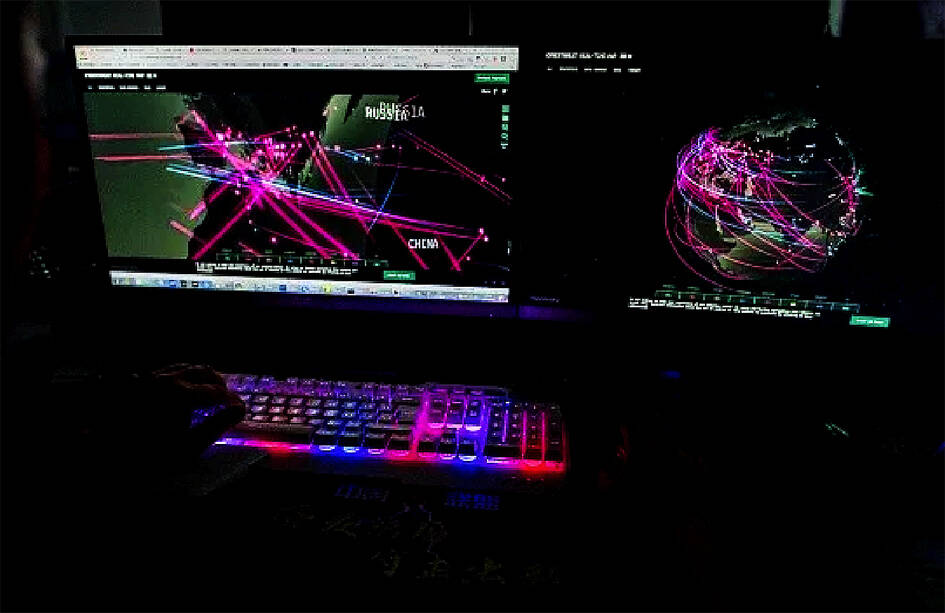Taiwanese cybersecurity specialists found 577 leaked documents which show that the Chinese Communist Party is engaging in “cognitive warfare” against Taiwan through cyberattacks and disinformation campaigns, a documentary released last month by Japanese public broadcaster NHK showed.
The filmmakers behind Tracking China’s Leaked Documents said they spent six months visiting seven countries, including Taiwan, where they interviewed members of TeamT5, a malware research and cybersecurity firm, which found the leaked documents.
TeamT5 said they discovered a string of mysterious URLs on the social media platform X, which they suspected could be accounts created by hackers or people who leaked data, which led them to the documents.

Photo: AFP
The files included technical information for launching cyberattacks, such as tools for hacking into Microsoft or Google e-mail accounts, as well as techniques for remotely controlling smartphones.
The leaked documents came from iSoon, a Shanghai-based firm that sells data obtained by hackers to the Chinese government, security agencies and state-owned enterprises.
The documents included more than 16,000 messages from chat logs of iSoon employees, indicating their relationship and dealings with Chinese security agencies and military, the documentary showed.
Many of the documents contained information on Taiwan, such as “demographic data” including names, addresses, telephone numbers; “road information data”; “architectural model data of Taiwanese cities”; and information from other databases, it said.
In the iSoon chat logs, an employee mentioned National Chengchi University (NCCU), questioning whether a university document had any special meaning. Another employee responded that “it is useful for think tanks to conduct research on cross-strait relations.”
NCCU Graduate Institute of Development Studies associate professor and chair Huang Jaw-nian (黃兆年) said the university’s server had been attacked, and some academics that had been consulted by government agencies had been targeted by hackers seeking to gain access to their e-mail accounts.
The National Center for High-Performance Computing said the hackers might have used the NCCU server as a “jump server,” attempting to obtain more important information in Taiwan.
The Internet protocol addresses mentioned in the iSoon documents matched those of Chinese hackers that many countries have already confirmed, TeamT5 said.
It added that iSoon also provided technical support for malware used by a notorious Chinese hacker organization APT41, which showed the association between iSoon and Chinese hackers.
Evidence of cognitive warfare campaigns were also found in iSoon’s leaked documents, such as online posts about spreading misinformation about a government proposal to introduce migrant workers from India, the documentary showed.
Many young women protested against the policy after reading discussions about the policy on Dcard, a popular online forum, it said.
The Taipei-based Doublethink Lab, which tracks online disinformation, said it found the original post that triggered the protest, titled “opening up to 100,000 Indian migrant workers will make Taiwan a sexual assault island,” which claimed the policy would increase incidents of sexual violence against women.
Shortly after the post, discussions on the issue grew on X, stirring unrest among young Taiwanese, many of whom voiced their opposition to the policy, it said.
Doublethink Lab analyst Lin Feng-Kai (林逢凱) said the example is an achievement of China’s cognitive warfare, as the choice of words used in the social media posts urging Taiwan not to cooperate with India implied that the authors behind the posts could be from China.

Three Taiwanese airlines have prohibited passengers from packing Bluetooth earbuds and their charger cases in checked luggage. EVA Air and Uni Air said that Bluetooth earbuds and charger cases are categorized as portable electronic devices, which should be switched off if they are placed in checked luggage based on international aviation safety regulations. They must not be in standby or sleep mode. However, as charging would continue when earbuds are placed in the charger cases, which would contravene international aviation regulations, their cases must be carried as hand luggage, they said. Tigerair Taiwan said that earbud charger cases are equipped

Foreign travelers entering Taiwan on a short layover via Taiwan Taoyuan International Airport are receiving NT$600 gift vouchers from yesterday, the Tourism Administration said, adding that it hopes the incentive would boost tourism consumption at the airport. The program, which allows travelers holding non-Taiwan passports who enter the country during a layover of up to 24 hours to claim a voucher, aims to promote attractions at the airport, the agency said in a statement on Friday. To participate, travelers must sign up on the campaign Web site, the agency said. They can then present their passport and boarding pass for their connecting international

Taiwan sweltered through its hottest October on record, the Central Weather Administration (CWA) said yesterday, the latest in a string of global temperature records. The main island endured its highest average temperature since 1950, CWA forecaster Liu Pei-teng said. Temperatures the world over have soared in recent years as human-induced climate change contributes to ever more erratic weather patterns. Taiwan’s average temperature was 27.381°C as of Thursday, Liu said. Liu said the average could slip 0.1°C by the end of yesterday, but it would still be higher than the previous record of 27.009°C in 2016. "The temperature only started lowering around Oct. 18 or 19

WEATHER Typhoon forming: CWA A tropical depression is expected to form into a typhoon as early as today, the Central Weather Administration (CWA) said yesterday, adding that the storm’s path remains uncertain. Before the weekend, it would move toward the Philippines, the agency said. Some time around Monday next week, it might reach a turning point, either veering north toward waters east of Taiwan or continuing westward across the Philippines, the CWA said. Meanwhile, the eye of Typhoon Kalmaegi was 1,310km south-southeast of Oluanpi (鵝鑾鼻), Taiwan’s southernmost point, as of 2am yesterday, it said. The storm is forecast to move through central